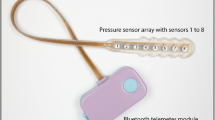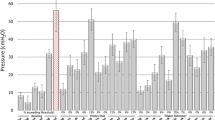Abstract
Introduction and hypothesis
The influence of intra-abdominal pressure (IAP) on prolapse development is poorly understood. Nonetheless, chronic cough, high BMI, or heavy lifting predisposes women to pelvic organ prolapse (POP). This study aims to develop and test a novel, wireless intra-vaginal pressure sensor (IVPS) to quantify intra-abdominal pressure changes across a range of well-defined activities.
Methods
The IVPS shape was based on silicone moulds of the vagina and was designed to sit in the proximal vagina. It is thin, compliant and negligibly distorts the surrounding tissues. Repeatability was assessed in 14 volunteers performing three sets of activities (cycles). Each cycle consisted of 18 activities. The IVPS was removed and reinserted after completing either the first or second of the three-cycle exercise routine (order). Participants independently inserted and removed the device. A nested split-plot, factorial ANOVA determined the effect of order using mean IAP increase (mean) and peak-to-peak fluctuations in IAP (amplitude) as dependent variables. Descriptive analysis examined the relative change in IAP across the activities. Cronbach’s alpha ®) determined repeatability.
Results
All women found the IVPS comfortable and easy to insert. There was excellent correlation between cycles across all variables, r > 0.935 (mean) and r > 0.964 (amplitude). The order was not statistically significant, demonstrating a highly repeatable measurement.
Conclusion
This is the first device to measure IAP at high frequency with the freedom of a wireless system. The IVPS aims to provide information to advise women better on suitable pre- and post-operative activities.





Similar content being viewed by others
References
Mens J, Hoek van Dijke G, Pool-Goudzwaard A, van der Hulst V, Stam H (2006) Possible harmful effects of high intra-abdominal pressure on the pelvic girdle. J Biomech 39(4):627–635
O’Dell KK, Morse AN, Crawford SL, Howard A (2007) Vaginal pressure during lifting, floor exercises, jogging, and use of hydraulic exercise machines. Int Urogynecol J 18(12):1481–1489
World Health Organisation (2012) Global recommendations on physical activity for health. WHO, Geneva. Accessed September 2012. Available from: http://whqlibdoc.who.int/publications/2010/9789241599979_eng.pdf
Ottesen M, Moller C, Kehlet H, Ottesen B (2001) Substantial variability in postoperative treatment, and convalescence recommendations following vaginal repair. A nationwide questionnaire study. Acta Obstet Gynecol Scand 80(11):1062–1068
IUGA (2011) Pelvic organ prolapse: A guide for women. IUGA, Florida
Delancey JO, Kane Low L, Miller JM, Patel DA, Tumbarello JA (2008) Graphic integration of causal factors of pelvic floor disorders: an integrated life span model. Am J Obstet Gynecol 199(6):610.e1–610.e5
Malbrain M, Cheatham M, Kirkpatrick A, Sugrue M, Parr M, De Waele J et al (2006) Results from the International Conference of Experts on Intra-abdominal Hypertension and Abdominal Compartment Syndrome. I. Definitions. Intensive Care Med 32(11):1722–1732
Haylen BT, de Ridder D, Freeman RM, Swift SE, Berghmans B, Lee J et al (2010) An International Urogynecological Association (IUGA)/International Continence Society (ICS) joint report on the terminology for female pelvic floor dysfunction. Neurourol Urodyn 29(1):4–20
Mouritsen L, Hulbaek M, Brostrom S, Bogstad J (2007) Vaginal pressure during daily activities before and after vaginal repair. Int Urogynecol J 18(8):943–948
Weir LF, Nygaard IE, Wilken J, Brandt D, Janz KF (2006) Postoperative activity restrictions: any evidence? Obstet Gynecol 107(2 Pt 1):305–309
Bhatia NN, Bergman A (1986) Urodynamic appraisal of vaginal versus rectal pressure recordings as indication of intra-abdominal pressure changes. Urology 27(5):482–485
Rosenbluth EM, Johnson PJ, Hitchcock RW, Nygaard IE (2010) Development and testing of a vaginal pressure sensor to measure intra-abdominal pressure in women. Neurourol Urodyn 29(4):532–535
Carey M, Slack M, Higgs P, Wynn-Williams M, Cornish A (2008) Vaginal surgery for pelvic organ prolapse using mesh and a vaginal support device. BJOG 115(3):391–397
Guaderrama NM, Nager CW, Liu J, Pretorius DH, Mittal RK (2005) The vaginal pressure profile. Neurourol Urodyn 24(3):243–247
Hendrickson A, Massey P, Cronan T (1993) On the test-retest reliability of perceived usefulness and perceived ease of use scales. MIS Q 17(2):227–230
Santos JR (1999) Cronbach’s Alpha: a tool for assessing the reliability of scales. J Ext 37(2):2TOT3
Hsu Y, Coleman TJ, Hitchcock RW, Heintz K, Shaw JM, Nygaard IE (2012) Clinical evaluation of a wireless intra-vaginal pressure transducer. Int Urogynecol J 23(12):1741–1747
Coleman TJ, Thomsen JC, Maass SD, Hsu Y, Nygaard IE, Hitchcock RW (2011) Development of a wireless intra-vaginal transducer for monitoring intra-abdominal pressure in women. Biomed Microdevices 14(2):347–355
Baggish M, Karram MM (eds) (2001) Atlas of pelvic anatomy and gynecologic surgery, 2nd edn. Elsevier/Saunders, St Louis
Schafer W, Abrams P, Liao L, Mattiasson A, Pesce F, Spangberg A et al (2002) Good urodynamic practices: uroflowmetry, filling cystometry, and pressure-flow studies. Neurourol Urodyn 21(3):261–274
Acknowledgements
Millar Instruments Ltd. Qi-Wern Lim constructed the silicone balloons and helped with data collection and analysis. Llewellyn Sims Johns constructed the mould and force loading rig. All the participants.
Funding
Supported by the Aoteoroa Foundation Postdoctoral Research Fellowship.
Conflicts of interest
Lynsey Hayward is the Treasurer of the Urogynaecological Society of Australasia (UGSA). None of the other authors had any conflicts of interest.
Author information
Authors and Affiliations
Corresponding author
Rights and permissions
About this article
Cite this article
Kruger, J., Hayward, L., Nielsen, P. et al. Design and development of a novel intra-vaginal pressure sensor. Int Urogynecol J 24, 1715–1721 (2013). https://doi.org/10.1007/s00192-013-2097-8
Received:
Accepted:
Published:
Issue Date:
DOI: https://doi.org/10.1007/s00192-013-2097-8




